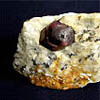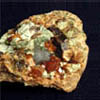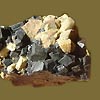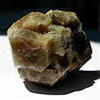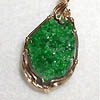- sale
- new items
- lovely beads
- wedding beads
- beads for teens
- for custom order
- newsletter
- recognition
- testimonials
- birthstones
- zodiac signs
- jewelry guide
SHOP BAG
![]() in your bag 0 items
in your bag 0 items
Garnet is not a mineral, it is a group of minerals that have been used since the Bronze Age as gemstones and abrasives. Garnets species are found in many colors including red, orange, yellow, green, blue, purple, brown, black, pink and colorless. The name "garnet" comes from the Latin GRANATUS (grain), possibly a reference to the Punica GRANATUM (pomegranate), a plant with red seeds similar in shape, size, and color to some garnet crystals. Six common species (but altogether, more than ten different gemstones!) of garnet are recognized based on their chemical composition, they make up two solid solution groups: Pyralspite garnets (almandine, pyrope, spessartine) and Ugrandite garnets (andradite, grossular, and uvarovite).
Almandine is a garnet of deep red color, inclining to purple. The name is a corruption of ALABANDICUS, which is the name applied by Pliny the Elder to a stone found or worked at Alabanda, a town in Caria in Asia Minor. Almandine is found in many localities: Sri Lanka (Ceylon ruby), the US (Alaska), East Africa, Austria (Tyrol). Large deposits of fine almandine garnets were found, some years ago, in the Northern Territory of South Australia (Australian ruby).
Pyrope is the only member of the garnet family to always display red color in natural samples, that is why it gets its name: from the Greek for fire and eye. The alternate names of pyrope are: Chrome pyrope, Bohemian garnet, Colorado ruby, Arizona ruby, etc. Pyrope is found in the western Alps, Czech Republic (the only source for a long time), Russia (Yakutia), South and East Africa, Mongolia, the US. The semi-precious stone rhodolite is a mixture of pyrope (about 70%) and almandine.
Spessartine is an orange-yellow to violet-red garnet, the name is a derivative of Spessart in Bavaria. The major sources for gem quality spessartine are Sri Lanka and Brazil. Other sources include Australia, Burma, India, Israel, Madagascar, the US (Colorado and Maine), Namibia, and Angola.
Andradite includes 3 varieties: melanite: black in color, usually not cut as a gemstone; demantoid: vivid green in color, one of the most valuable and rare stones in the world; topazolite: yellow-green in color and sometimes of high enough quality to be cut into a faceted gemstone. Andradite also is found in rarely colorless. Andradite was named after the Brazilian mineralogist Jose Bonifacio de Andrade e Silva. It is found in Italy, the Ural Mountains of Russia, the US (Arizona and California), Namibia.
Grossular belongs to another garnet group. The name grossular is derived from the botanical name for the gooseberry, GROSSULARIA, in reference to the green garnet of this composition that is found in Siberia. Other shades include cinnamon brown (hessonite or cinnamon stone variety), red, and yellow. A highly valued grossular garnet from Kenya and Tanzania is called tsavorite. This garnet was discovered in the 1960s in the Tsavo area of Kenya, from which the gem takes its name. Viluite is a variety name of grossular, that is not a recognized mineral species. It is usually olive green though sometimes brownish or reddish, brought about by impurities in the crystal. It comes from the Vilyuy river area in Siberia. Grossular is known by many other names, that include: South African jade, garnet jade, Transvaal jade, African jade, etc.
Uvarovite is a rather rare garnet, the only consistently green garnet species, with a beautiful emerald-green color. It is named after Count Sergei Semenovitch Uvarov (1765-1855), a Russian statesman and amateur mineral collector. Uvarovite is found in the Ural mountains of Russia, Finland, Spain, Canada, Norway, and South Africa.
The rarest of all garnets is the blue garnet, discovered in the late 1990s in Bekily, Madagascar. It is also found in parts of the US, Russia and Turkey. It changes color from blue-green in the daylight to purple in incandescent light. Other varieties of color-changing garnets exist. In daylight, their color ranges from shades of green, beige, brown, gray, and blue, but in incandescent light, they appear a reddish or purplish/pink color. Because of their color changing quality, this kind of garnet is often mistaken for Alexandrite.
Pure crystals of garnet are used as gemstones to make jewelry. Garnet sand is a good abrasive, and a common replacement for silica sand in sand blasting. Mixed with very high pressure water, garnet is used to cut steel and other materials in water jets.
Garnet facts
1. Garnet is the state mineral of the state of Connecticut.
2. Garnet is the state gemstone of the state of New York.
3. The brilliant green garnet from the Urals was a favorite gem of Russian star jeweler Carl Faberge.


